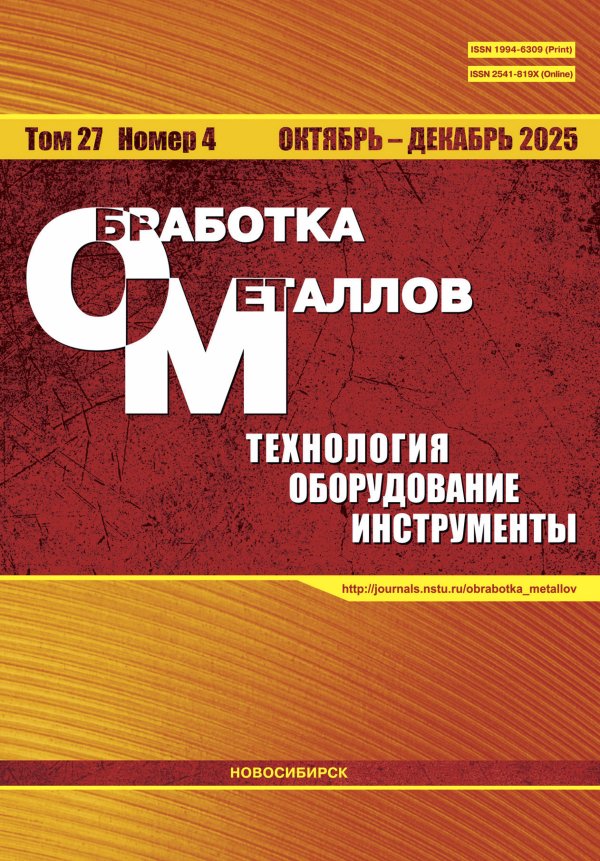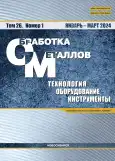Том 26, № 1 (2024)
ТЕХНОЛОГИЯ
Исследование изменения геометрических параметров образцов, наплавленных методом GMAW при воздействии на электрическую дугу продольного магнитного поля
Аннотация
 6-21
6-21


Оптимизация режимов селективного лазерного плавления порошковой композиции системы AlSiMg
Аннотация
 22-37
22-37


Особенности расчета температуры резания при высокоскоростном фрезеровании алюминиевых сплавов без применения СОЖ
Аннотация
 38-54
38-54


ОБОРУДОВАНИЕ. ИНСТРУМЕНТЫ
Адаптация системы ЧПУ станка к условиям комбинированной обработки
Аннотация
 55-65
55-65


Эластичные хоны для полирования профилей зубьев термообработанных цилиндрических колес специального назначения
Аннотация
Введение. Важнейшей составляющей технологического процесса изготовления зубчатых колес ответственных изделий является операция хонингования зубьев.Особые требования предъявляют к качеству поверхности зубчатых колес специального назначения, где применяли импортные абразивные инструменты, поставки которых в современных экономических условиях невозможны. Цель работы: разработка рецептуры, технологической оснастки и технологии изготовления эластичных алмазных зубчатых хонов взамен импортных для хонингования зубьев зубчатых колес специального назначения. Методы исследования. Предметом исследования являются образцы импортных эластичных хонов и создаваемые отечественные аналоги. Определяли механические свойства, морфологию и химический состав абразивного (алмазного) слоя рабочей поверхности зубьев и зубчатого венца. Содержание химических элементов контролировали в отдельных точках поверхности и сканированием по площади на растровом электронном микроскопе. Определяли рецептуру и технологию производства зубчатых хонов. Результаты и обсуждение. Разработаны конструкции пресс-форм для формообразования абразивного слоя и ступицы зубчатого хона. Выявлены особенности морфологии материала рабочего слоя и зубчатого венца эластичного алмазного хона. На основании проведенных исследований определены отечественные аналоги материалов составляющих элементов хона. Рассматривали две технологии изготовления: методом прессования и литья под давлением. Для отработки технологии изготовлены две пресс-формы: упрощенная модель, состоящая из двух зубьев, и круглая пресс-форма. Анализировали несколько способов изготовления зубьев хона: изготовлениеабразивного слоя с различной степенью предварительнойвулканизацией, последующим введением материала зубчатого венца и окончательной вулканизацией всего изделия. Определяли механические показатели материалов рабочего абразивногослоя и зубчатого венца. Исследовали химический состав составляющих хона и пограничной зоны. В результате проведенных исследований даны рекомендации по рецептуреабразивного слоя и зубчатого венца, технологии изготовления зубчатого хона, предназначенного для окончательной обработки зубьев термообработанных цилиндрических колес специального назначения.
 66-79
66-79


Синтез механизма привода ремиз
Аннотация
 80-98
80-98


МАТЕРИАЛОВЕДЕНИЕ
Изучение влияния содержания гафния и эрбия на формирование микроструктуры при литье алюминиевого сплава 1590 в медный кокиль
Аннотация
 99-112
99-112


Изучение эволюции микроструктуры и механических свойств в алюминиевом сплаве 1570 с добавкой 0,5 % гафния
Аннотация
 113-128
113-128


Взаимосвязь микроструктуры с ударной вязкостью металлов сварного шва трубных высокопрочных низколегированных сталей (обзор исследований)
Аннотация
 129-154
129-154


Полуэмпирическое моделирование температуры резания и шероховатости поверхности при точении конструкционных материалов твердосплавным инструментом с покрытием TiAlN
Аннотация
 155-174
155-174


Исследование электроэрозионной обработки криогенно обработанных бериллиево-медных сплавов (BeCu)
Аннотация
 175-193
175-193


Исследование влияния комбинированного модификатора из отходов кремниевого производства на свойства серых чугунов
Аннотация
 194-211
194-211








